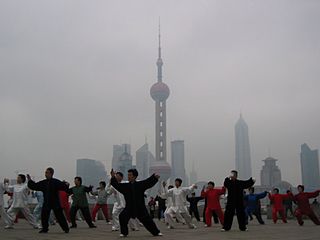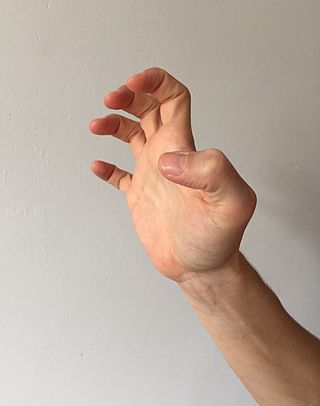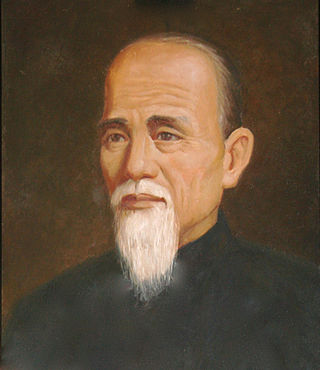
Hung Ga (洪家), Hung Kuen (洪拳), or Hung Ga Kuen (洪家拳) is a southern Chinese martial art belonging to the southern Shaolin styles. The hallmarks of Hung Ga are strong stances, notably the horse stance, or "si ping ma" (四平馬), and strong hand techniques, notably the bridge hand and the versatile tiger claw. Traditionally, students spent anywhere from several months to three years in stance training, often sitting only in horse stance from half an hour to several hours at a time, before learning any forms. Each form could then take a year or so to learn, with weapons learned last. In current times, this mode of instruction is generally considered impractical for students, who have other concerns beyond practicing kung fu. However, some instructors still follow traditional guidelines and make stance training the majority of their beginner training. Hung Ga is sometimes mischaracterized as solely external—that is, reliant on brute physical force rather than the cultivation of qi—even though the student advances progressively toward an internal focus.

Qin Na is the set of joint lock techniques used in the Chinese martial arts to control or lock an opponent's joints or muscles/tendons so they cannot move, thus neutralizing the opponent's fighting ability. Qin Na Shu literally translates as lock catch technique. Some schools simply use the word na ("hold") to describe the techniques. Qinna features both standing and ground-based grappling techniques.

Northern Praying Mantis is a style of Chinese martial arts, sometimes called Shandong Praying Mantis after its province of origin. It was created by Wang Lang (王朗) and was named after the praying mantis, an insect, the aggressiveness of which inspired the style. One Mantis legend places the creation of the style during the Song dynasty when Wang Lang was supposedly one of 18 masters gathered by the Abbot Fu Ju (福居), a legendary persona of the historical Abbot Fu Yu, to improve Shaolin martial arts. However, most legends place Wang Lang in the late Ming dynasty.

Ten Tigers of Canton or Ten Tigers of Guangdong refers to a group of ten Chinese martial artists from Guangdong Province lived around the 19th century during the Qing dynasty in China. They were said to be the greatest fighters in Guangdong during the Qing era. Much of their existence has been embellished by folk legends and stories passed down from generation to generation.

Southern Praying Mantis is a Chinese martial art originating with the Hakka people. It is most closely associated with Hakka-origin styles such as Southern Dragon Kung Fu and Bak Mei.
A combat sport, or fighting sport, is a contact sport that usually involves one-on-one combat. In many combat sports, a contestant wins by scoring more points than the opponent, submitting the opponent with a hold, disabling the opponent, or attacking the opponent in a specific or designated technique. Combat sports share a long history with the martial arts.

In Chinese martial arts, there are fighting styles that are modeled after animals.

Jow Ga kung fu is a form of Chinese martial art. It was founded by Jow Lung who was born in 1891, on the eleventh day of the third lunar month in Sa Fu Village of the Guangdong province, and died in 1919. His father was Jow Fong Hoy and his mother’s maiden name was Li. At the time of its inception, this particular style of kung fu was labeled as having the head of Hung Gar, the tail of Choy Gar and the patterns of the tiger and leopard, or simply Hung Tao Choy Mei. It was so labeled because the essential techniques incorporated the muscular and mighty movements of Hung Gar and the swift footwork and complex kicking of Choy Gar, making it a very effective form of self defense with emphasis on simultaneous attack and defense.

Hong Xiguan (1745–1825) was a Chinese martial artist who lived in the Qing dynasty. He was also an influential figure in the Southern Shaolin school of Chinese martial arts. His name is also alternatively romanised as Hung Hei-gun, Hung Hei-koon, Hung Hei-kwun, Hung Hsi-kuan, and similar renditions. He was believed to be the creator and founder of Hung Ga Kuen.

There are hundreds of different styles of Chinese martial arts, each with their own sets of techniques and ideas. The various movements in kung fu, most of which are imitations of the fighting styles of animals, are initiated from one to five basic foot positions: normal upright posture and the four stances called dragon, frog, horse riding, and snake. The concept of martial arts styles appeared from around the Ming dynasty (1368–1644). Before the Ming period, martial skills were commonly differentiated mainly by their lineage. There are common themes among these styles which allow them to be grouped according to generalized "families", "fractions", "class", or "schools" of martial art styles. There are styles that mimic movements from animals, or otherwise refer or allude to animals or mythical beings such as dragons, and others that gather inspiration from various Chinese philosophies or mythologies. Some deeply internal styles tend to focus strongly on practice relating to harnessing of qi energy, while some more-conspicuously external styles tend more to display skills and abilities in competition or exhibition.

Chan Tai San was a Chinese martial arts grandmaster. Often called one of China's "living treasures", Chan was featured as such on the cover of Inside Kung Fu magazine in 1996.

Various martial arts have been attributed to or associated with Zhou Tong, the archery teacher of Song Dynasty general, Yue Fei. This is because assorted wuxia novels and folk legends portray him as being either a Shaolin monk or a lay disciple of Shaolin. Some of these skills range from mastery of the bow, double swords and Chinese spear to that of Wudang hard qigong, Chuojiao boxing and even magical X-ray eyes. However, the oldest historical record that mentions his name only says he taught archery to Yue Fei. Nothing is ever said about him knowing or teaching a specific style of Chinese martial arts.

Fut Ga Kuen or Buddhist Family Fist is a relatively modern Southern Shaolin style of Kung Fu devised primarily from the combination of Hung Ga Kuen 洪家 and Choy Gar 蔡家 Kuen. The style utilizes mostly punches, palm strikes and low kicks, further characterized by evasive footwork, circular blocks and using the opponent's force against them.

Fu Jow Pai, originally named "Hark Fu Moon" is a Chinese martial art that has its origins in Hoy Hong Temple out of Tiger techniques of Five Animal Kung Fu, Ng Ying Kungfu. The system "was modeled after the demeanor and fighting strategy of an attacking tiger. Techniques unique to Fu-Jow Pai are ripping, tearing, clawing and grasping applications."

Choy Gar, also Caijia Quan, is a Chinese martial art deriving its name from the Cantonese-born founder, Choy Gau Lee (蔡九儀), and is one of the five main family styles of Kung Fu in Southern China. It was taught to him by a monk named Yi Guan. This style, founded in the 17th century, is a combination of rat and snake styles emphasizing on swift footwork and rapid strikes.

Choy Lee Fut is a Chinese martial art and wushu style, founded in 1836 by Chan Heung (陳享). Choy Li Fut was named to honor the Buddhist monk Choy Fook who taught him Choy Gar, and Li Yau-san (李友山) who taught him Li Gar, plus his uncle Chan Yuen-wu (陳遠護), who taught him Hung Kuen, and developed to honor the Buddha and the Shaolin roots of the system.

Chan Heung was the founder of the Choy Li Fut martial arts system.

Snake kung fu is a Shaolin boxing style, one of several Chinese martial arts known as "snake boxing" or "fanged snake style" that imitate the movements of snakes. Proponents claim that adopting the fluidity of snakes allows them to entwine with their opponents in defense and strike them from angles they would not expect in offense. Snake style is said to especially lend itself to applications with the Chinese straight sword. The snake is also one of the animals imitated in Yang-style tai chi, Baguazhang and Xingyiquan. The sinuous, fluid motion of the snake lends itself to the practical theory that underlies the "soft" martial arts.

Drunken boxing also known as Drunken Fist, is a general name for all styles of Chinese martial arts that imitate the movements of a drunk person. It is an ancient style and its origins are mainly traced back to the Buddhist and Daoist religious communities. The Buddhist style is related to the Shaolin temple while the Daoist style is based on the Daoist tale of the drunken Eight Immortals. Zui quan has the most unusual body movements among all styles of Chinese martial arts. Hitting, grappling, locking, dodging, feinting, ground and aerial fighting and all other sophisticated methods of combat are incorporated.
Chan Kowk-wai was born on April 3, 1936, at Taishan in the province of Guangdong, China. He introduced traditional Shaolin kung fu to Brazil through the China-Brazil Kung Fu Academy. His disciples have spread as far as the USA, Canada, Spain, Argentina and the Czech Republic.










